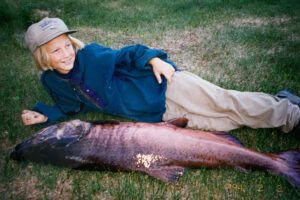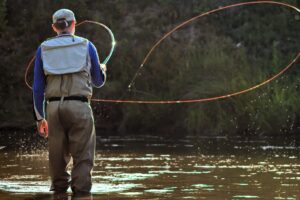June 28, 2022
Introduction to Talachulitna River Fishing
The Talachulitna River, nestled within the breathtaking Alaskan wilderness, provides an unparalleled fishing experience for both novice and seasoned anglers. Starting from early June, the river becomes a hub of activity as the native fish species, including rainbow trout, arctic grayling, and dolly varden, emerge from their winter dormancy. The river’s pristine waters and diverse ecosystem create an ideal environment for these fish to thrive, making it a prime destination for angling adventures.
As the ice melts and the river begins to flow more freely, the behavior of the fish shifts significantly. With the onset of warmer temperatures, fish become more active, feeding voraciously and moving to different parts of the river in search of food. This seasonal transition offers anglers the perfect opportunity to target these species using a variety of fishing techniques, from fly fishing to spin casting.
One of the most appealing aspects of fishing on the Talachulitna River is its accessibility. Despite its remote location, the river can be reached relatively easily by floatplane or boat, making it a convenient yet secluded spot for fishing enthusiasts. This accessibility, combined with the river’s natural beauty and rich biodiversity, makes it a must-visit destination for anyone looking to experience the best of Alaskan fishing.
The Talachulitna River’s fishing season is largely dictated by the weather and water conditions. While early June marks the beginning of the prime fishing period, the season extends well into September, with each month offering unique opportunities. For instance, rainbow trout are particularly abundant in June and July, while arctic grayling are more prevalent in the later summer months. Dolly varden, on the other hand, can be found throughout the season, providing a consistent target for anglers.
Overall, the Talachulitna River offers a rich and rewarding fishing experience that is deeply intertwined with the rhythms of nature. Whether you’re drawn by the challenge of catching a trophy-sized rainbow trout or the allure of the river’s untouched beauty, this Alaskan gem promises an unforgettable angling adventure.
Rainbow Trout, Arctic Grayling, and Dolly Varden: The Native Trio
The Talachulitna River is renowned for its diverse and vibrant fish population, particularly the native trio of rainbow trout, arctic grayling, and dolly varden. These species not only contribute to the ecological richness of the river but also provide exhilarating experiences for anglers.
Rainbow trout are highly sought after by sports fishermen due to their striking appearance and spirited behavior. Characterized by their iridescent, multi-colored markings and a vivid pink stripe along their sides, these fish are known for their acrobatic leaps when hooked. Rainbow trout thrive in the cool, clear waters of the Talachulitna, often found in deeper pools and near underwater structures. Anglers targeting rainbow trout should consider using lures that mimic small fish or insects, such as spinners or streamer flies. Techniques like drift fishing or fly fishing are particularly effective in enticing these dynamic predators.
Arctic grayling, another native gem, are distinguished by their large, sail-like dorsal fins adorned with intricate patterns. These fish are abundant in the Talachulitna River and are known for their willingness to bite, making them a favorite among both novice and experienced anglers. Arctic grayling are typically found in slower-moving sections of the river, especially near gravelly bottoms where they feed on aquatic insects. Dry flies, nymphs, and small spinners are effective baits for catching grayling. Their feeding behavior makes fly fishing an optimal technique, with accurate casting and gentle presentations yielding the best results.
Dolly varden, with their vivid coloring of olive green, bright red, and orange spots, add a splash of vibrancy to the Talachulitna’s waters. These fish are particularly active during their spawning season, when their colors become even more pronounced. Dolly varden prefer cold, fast-flowing streams and are often found in similar habitats as rainbow trout. Anglers can use a variety of baits to attract dolly varden, including streamers, spoons, and live bait like salmon eggs. Techniques such as drift fishing and trolling are effective in securing a catch.
The Talachulitna River, with its native trio of rainbow trout, arctic grayling, and dolly varden, offers a unique and rewarding angling experience. Understanding the characteristics and behaviors of these species enhances the likelihood of a successful and memorable fishing adventure.

The Salmon Spectacle: Five Species of Pacific Salmon
The Talachulitna River is renowned for its vibrant salmon runs, offering anglers a unique opportunity to target five distinct species of Pacific salmon. The spectacle begins with the arrival of the king salmon, also known as Chinook, typically appearing in the river from late May to early July. These majestic fish are the largest of the Pacific salmon, and their sheer size and strength demand robust gear and strategic angling techniques. Anglers often find success using large spinners, spoons, or brightly colored flies to entice these formidable fish.
Following closely are the sockeye salmon, or red salmon, which migrate in substantial schools. Their run peaks from mid-June to early August. Sockeye salmon are noteworthy for their striking, crimson coloration during spawning. Anglers targeting sockeye often employ small, brightly colored flies or lures, mimicking the plankton they feed on in the ocean. The challenge lies in presenting these offerings in a natural drift, requiring precision and patience.
Next in the succession are the chum salmon, arriving from late June to early August, and the pink salmon, which appear in even-numbered years from late July to mid-August. Chum salmon, or dog salmon, are known for their aggressive nature, making them a thrilling catch. They respond well to brightly colored streamers and jigs. Pink salmon, or humpies, are smaller but exceptionally abundant. Anglers often use small spoons or flies in pink hues to match their prey preferences.
The salmon season culminates with the arrival of the silver salmon, or coho, from late July to September. These fish are celebrated for their acrobatic fights and high-quality meat. Anglers targeting silver salmon often use spinners, spoons, or brightly colored flies, employing a varied retrieval speed to trigger strikes. Their aggressive nature and propensity for aerial displays make them a favorite among sport fishers.
Understanding the migration patterns and employing the right techniques for each salmon species can significantly enhance the angling experience on the Talachulitna River. Whether you are targeting the mighty king salmon or the agile silver salmon, the river offers a rich and rewarding fishing adventure.
September Fishing: The Grand Finale
As the summer season winds down, September unveils some of the most thrilling fishing opportunities on the Talachulitna River. This period is particularly remarkable for targeting large rainbow trout and well-fed arctic grayling. With the departure of the salmon, these fish become the primary focus for anglers, offering a unique and rewarding challenge.
During September, rainbow trout can be found in deeper pools and slower-moving currents. These fish are often larger and more aggressive, having fed on the abundant salmon eggs and fry throughout the summer. The best spots to target them include the confluences of tributaries and areas with substantial underwater structures such as fallen trees and large boulders. Using streamers and nymphs that imitate small fish and aquatic insects can be particularly effective. Patterns like the Dalai Lama, Dolly Llama, and Egg-Sucking Leech are highly recommended.
Arctic grayling, on the other hand, tend to frequent the shallower, faster stretches of the river. They are often seen rising to surface flies, making dry fly fishing an exhilarating experience. Effective dry fly patterns for this time of year include the Elk Hair Caddis, Parachute Adams, and Royal Wulff. For subsurface action, small nymphs and bead-heads work wonders, especially in riffles and runs where grayling are actively feeding.
Seasoned fishermen advise paying close attention to water temperatures and weather patterns. Cooler temperatures can trigger more active feeding behaviors, particularly during overcast days when fish feel safer venturing into shallower waters. Personal anecdotes highlight the importance of stealth and patience. One angler recalls a memorable September afternoon when a carefully presented streamer in a shaded pool yielded a trophy-sized rainbow trout after hours of anticipation.

In conclusion, September on the Talachulitna River offers unparalleled fishing experiences. By targeting the right spots and using the appropriate flies and lures, anglers can make the most of the late-season opportunities and create lasting memories on this majestic river.
Fishing begins on the Talachulitna River in the first part of June. Rainbow Trout, Arctic Grayling, and Dolly Varden are ravenous and aggressive after a long winter of dormancy. These three species are native to the river and are available throughout the season.
The Rainbow Trout of the Talachulitna River are wild, native trout famed for their brilliant markings. Their dramatic leaps and tendency to run hard and fast make them a favorite among sports fishermen.
There are five species of Pacific salmon, and all of them – the King, Sockeye, Silver, Chum, and Pink – migrate up the Talachulitna. The first to arrive is the mighty Chinook ( King) Salmon. It is the largest and most fished for by sport fishermen. The King is generally taken on big spoons and spinners. However, many fly fishermen have experienced the ultimate in angling adventure when a King has taken their large, heavily-weighted streamer fly. After an hour of concentrated effort and aching muscles, you’ll know you’ve done battle with an extraordinary fish!
- As the King Salmon progress upstream, the Sockeye Salmon begin arriving. Their destination: the headwaters of the Talachulitna. Sockeyes travel up the river in large schools. During the last two weeks of July, you can stand knee-deep in the river, surrounded by these big, brilliant fighters! The moment a Sockeye strikes, the water explodes and the fight is on! The firm, red, rich meat of the Sockeye is the most valued of all the salmon.
- The last week of July and all through August, the Tal is home again to the Chum and Pink Salmon. The Chum is a swift, powerful fighter and provides a thrilling contest. You will marvel at the sheer number of Pink Salmon which inhabit the Tal. Beginners and children will have a heydey when nearly every cast produces a strike!
- The entire month of August finds the Coho (Silver) Salmon entering the Tal. They are fresh, strong, and of perfect eating quality. The Silver will strike flies and lures with equal zest and are truly a sport fishermen’s dream come true. They are well known for their three-foot leaps out of the water and their sizzling runs for deeper pools.
- Septemeber produces the larger (26 to 30-inch) Rainbows – fat and strong from their summer’s feeding. All the salmon have moved out and, as with the Rainbows, Arctic Grayling are also fat (averaging 16 to 18 inches) but still hungry! Like the month of June, the Tal is teeming with large numbers of Graying content to strike just about any fly or lure. September is truly an exciting time here on the Talachulitna River for the discriminating anglers!




